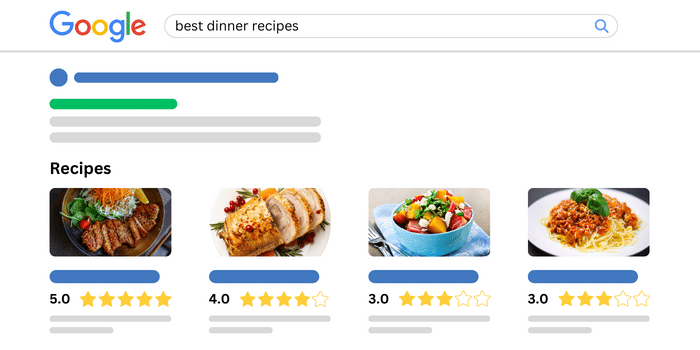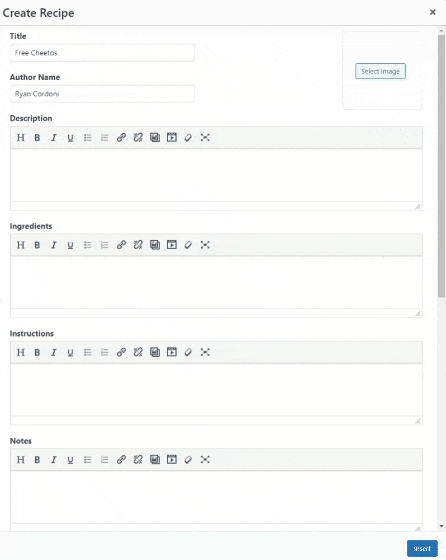Not seeing your recipes on the search engine results page? Don't have rich snippet recipes in your content? That could be why!
Recipe rich snippets add flavor to your content. They give searchers a taste of your recipes in the search results, paired with star ratings and cook time.
Curious about how to get these for your own blog? Keep reading!
In this guide, we'll show you how to get rich snippet recipes on Google. And if you're not a tech whiz, don't worry! We've got a plugin to help you master rich recipe snippets.
Ready to boost your search traffic? Let's get cooking!
What is an example of a rich snippet?
In search engine results pages (SERPs), recipe rich snippets show images, ratings, and cook times.
Here's an example from Pinch of Yum for “Perfect Chocolate Chip Cookies Recipe,”

See how it has a tempting picture, a high rating, and helpful cook time? That's a rich snippet at work!
Rich snippets are also practical for Search Engine Optimization (SEO). They dress up your content for the SERPs, potentially boosting your click-through rate. While extra clicks and attention don't directly boost your Google ranking, they can eventually impact it.
How, you ask?
If people engage with your content and stay on your website, you send positive vibes to Google that you're giving searchers what they want!
And that gives you a little bump in the search results.
Now that you know what they are, let's move on to making a rich snippet.
Prepping your rich snippet recipes
First, let's cover what recipe schema markup is.
This is a special schema type that tells search engines about your recipe page. It covers the title, ingredients, and other related info. By adding this markup, you help search engines understand your content better.

You have two choices to get those eye-catching recipe rich results: the DIY way or the easy way. (We'd choose the easy way, but who wouldn't?)
Read on for a deeper dive into these two methods.
The DIY approach
If you're comfortable with code, feel free to add structured data to your pages yourself.
It's important to note: You're in total control here. You have to go into your website's HTML and add structured data. This data tells search engines about your recipes. To use JSON-LD structured data, follow Schema.org rules carefully.
And, if none of that made sense to you, keep reading for the easy way!
The easy way
We'll be upfront here: the easy way involves using a plugin.
But that's because recipe plugins are fantastic. They implement structured data markups for you, meeting search engines' standards. That way, you can focus on creating the next popular dish while your plugin takes care of all things tech.
That's why we recommend Tasty Recipes by WP Tasty.
All you have to do is add a recipe card to your post. Just pour in your recipe content, and Tasty Recipes bakes the schema markup for you. It makes sure the most important parts, like ingredients, cook time, and star ratings, are ready to be served on the SERPs.
Think of it as your partner in making your content work its way to the featured snippets!
Creating your rich snippet recipes
Recipe schema markup with Tasty Recipes is straightforward and user-friendly.

Here's how to craft a recipe rich snippet with Tasty Recipes step by step:
- Install Tasty Recipes: Install the Tasty Recipes plugin on your WordPress site. It's quick and easy.
- Create a New Recipe Post: Navigate to ‘Add New' in your post editor. Craft an attention-grabbing title, whip up a compelling intro, and prep for the next steps.
- Add recipe details: Go to the Tasty Recipes interface. Fill out the recipe card with the recipe name, servings, prep time, cook time, key ingredients, and directions.
- Optimize Your Content: Find keywords for your cooking recipes. Remember the cookie example from earlier? With that, you'd include terms related to chocolate chip cookies in your content.
- Publish: Tasty Recipes makes your recipe look beautiful easily, so click publish! Your search-friendly recipe is ready to go.
Tasty Recipes makes your life easier. It helps your recipe website show your love for food and improve your site's visibility, one rich snippet at a time.
Verifying your schema markup
Always double-check to ensure your schema markup is accurate and that no info for your rich snippets is missing. You want to be sure that search engines like Google can read your recipe loud and clear.
Tools like Google's Rich Results Test or Google Tag Manager simplify the process.

Here's how to use the Google Rich Results Test:
- Go to the tool.
- Enter your recipe post's URL.
- Let the tool analyze your schema markup.
The tool checks for mistakes that might stop your recipe from showing up correctly.
When the Rich Results Test gives you feedback, take it as constructive criticism. It might notice something you've overlooked, like a star rating or cook time.
Tasty Recipes is made to prevent mistakes, but this step is your safety net.
Monitoring your results
After you deck out your recipe pages, it's time to see how they're faring on the SERPs.
An excellent tool for this is Google Search Console. To find important data about your recipes, visit the Performance tab. You can see the click-through rate, impressions, clicks, and average positions.
Under the ‘Search Appearance' section, there’s a spot to look at how your rich snippets are performing. This shows you which recipes people like and which ones might need more seasoning for SEO.
The internet always changes. Check back often to catch ranking shifts and adjust your strategies.
Staying updated on schema markup guidelines
Keeping your blog's schema markup fresh is like always having the latest cookbook.
Here's how to stay on top of things:
- Research the latest tips on SEO for food bloggers.
- Join food blogger forums and groups.
- Watch for updates from Google Search Console.

Using Tasty Recipes helps with staying up to date, too! Tasty Recipes automatically updates when schema.org or Google changes the recipe for success. This keeps your blog looking its best in the search results.
So, there's no need to dig through the guidelines yourself. Tasty Recipes does the heavy lifting for you.
What’s your next step to snippet success?
So, what's your plan to garnish your site with rich snippets that reel in the readers?
With Tasty Recipes and some SEO effort, you can reach featured snippets, get more recipe reviews, and better search rankings.
That's the goal, right?
If you haven't yet, download Tasty Recipes to take the next step.
We want to hear about your next move. What recipes will you showcase, and how will you ensure they're the talk of the digital town?
Let us know in the comments!
